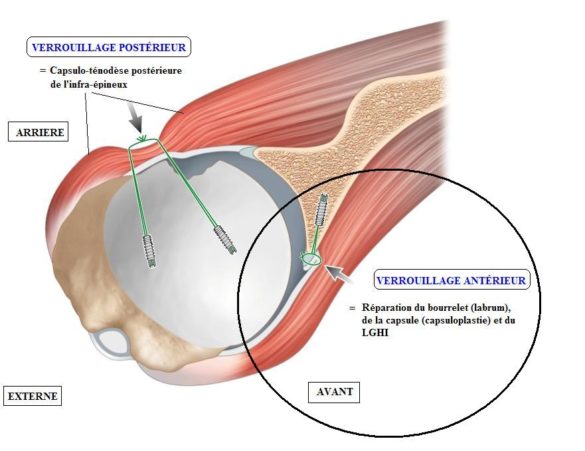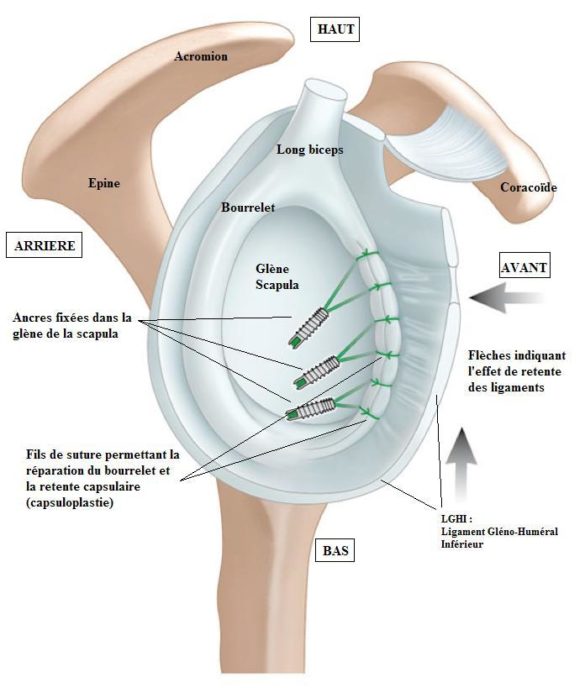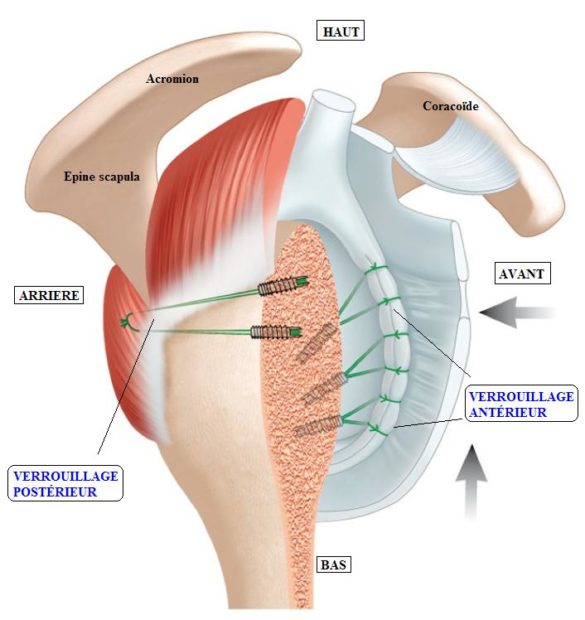Regarding anterior and inferior lesions:
The classic intervention of ‘Arthroscopic Bankart’:
It includes a good repositioning of the antero-inferior labrum and inferior glenohumeral ligament with resorbable or metallic small anchors (2-3 mm)


Associated gestures according to the case:
- reinsertion of the upper labrum or tenodesis of the biceps in case of instability (SLAP) or associated tendonitis, sometimes using an anchor or a tunnel in the bone
- bone reinsertion in case of fracture if it is technically possible (anchors or screws)
the most obvious lesion, when present, is the posterior notch at the level of the humeral head resulting from the impact of the head on the glenoid during articular dislocation.
It is a bone settlement rather than a cookie cutter.
It is voluminous and can be seen on standard X-rays of the shoulder and on MRI or CT scans.
They are sometimes minimal or invisible on the exams but undoubtedly lesions are in our opinion systematically present in the joint capsule and infra-spinous tendon that have been stretched at least during joint dislocations.
A posterior repair procedure is performed at this level in the form of a capsulo-tenodesis (fixation-retentation of the capsule and infra-spinous tendon)
For this purpose, we perform a posterior capsulotendinous fixation of the zone close to that without cartilage of the humeral head and not at the notch because of the extreme variation of position of these posterior notches that are not always ‘refillable’ ( or with a possible functional limitation of the shoulder).

In total :
Surgical procedures performed before are rarely practiced in isolation because it is now accepted in the profession that this is not sufficient for the majority of patients operated true relapsing dislocations. They are now made jointly with with a stabilization back.
We have developed at the Union clinic the principle of BIPOLAR LOCK, which has a double anterior and posterior stabilization, which gives much better results than an isolated anterior stabilization.

Modalities of the intervention:
Hospitalization: one to two nights
Anesthesia: Loco-regional associated with general anesthesia.
Duration of intervention: 30 minutes to one hour
Immobilization: Dujarrier elbow to body 1 month
Physiotherapy: immediate passive with limitation of amplitudes
Car driving resume: 4 to 6 weeks
stop work: sedentary work without driving 10 to 15 days, sedentary work 6 weeks, manual work 3 months minimum
stop sport: 3 months to 6 months (sports at risk of recurrence)
Failure rate: 5 to 10%. There is no technique that can ensure 100% efficiency
Do not confuse a failure (recurrence of a dislocation for an effort or a minor trauma) with a recurrence related to a new severe trauma (Veneer Rugby, Fall bike or mountain bike, ski).
Contraindications to Bipolar Lock
Absolutes:
- Bone loss in the anterolateral glenoid
- A tear on the humeral side of the capsule and ligaments (HAGL lesion)
A stop shoulder is then in our opinion the only effective intervention!
Relatives (as the case may be):
- Sports level (high level competition) according to sports
- Joint hyperlaxity,
- voluminous notch
We will also prefer a stop …
